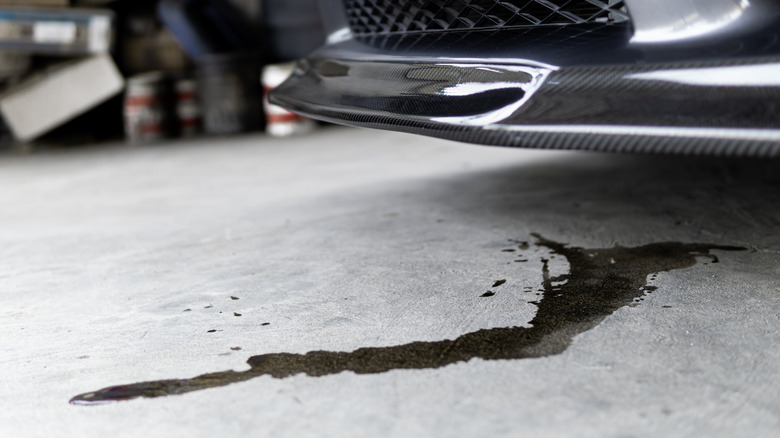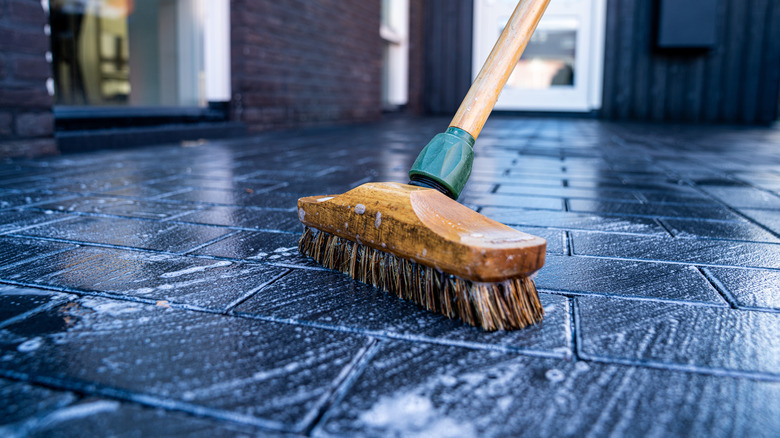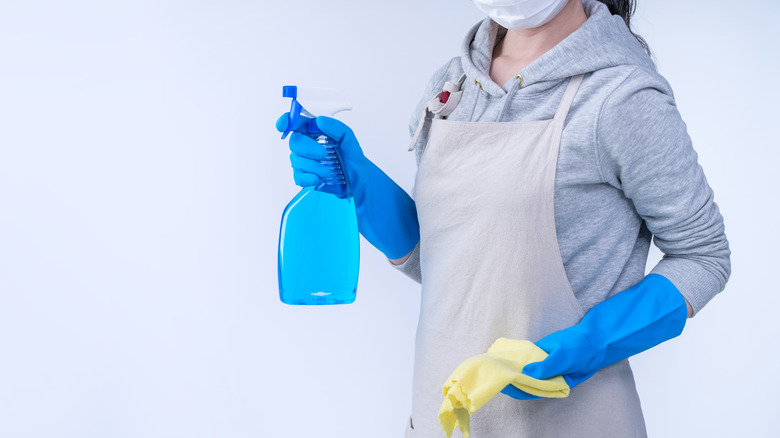Reach For This Product To Bring Your Stained Concrete Back To Life
When you are seeking a unique type of flooring to use inside your home, concrete flooring is right for a lot of spaces. It also works well as a patio that adds style to any yard. It's a natural selection for driveways and garages, too. Concrete has significant durability and it fits almost any shape and space well while being a cost-effective option versus other materials. Using concrete flooring indoors or outdoors isn't always the perfect solution, though. This material is subject to flaking and eroding. It also can end up with unwanted stains and discoloration that causes the material to appear aged before it should. Fortunately, you often can use ammonia to remove the discoloration and give it a fresh, new look. A few other common household products also improve the look of concrete with unwanted stains, but ammonia is a highly effective option.
Ammonia works so well for cleaning that it appears in many different household cleaning products. Commonly, it appears in products made for windows, floors, toilets, mirrors, and ovens. Ammonia is especially strong at removing certain types of stains, such as animal fats and vegetable oils. It also works nicely for cooking grease and other tough stains.
It's important to note that you should not pour ammonia on your concrete unless you are sure the ammonia is safe to use with any sealants that are on the flooring or patio. Do not use it on polished or stamped concrete flooring.
How to use ammonia to clean unwanted stains on concrete
To use the ammonia on your concrete floor, garage, or patio stains, you need to dilute it. Fill a bucket with a gallon of warm water before adding 1 cup of ammonia. Put on safety goggles and rubber gloves before working to protect yourself. Use a sponge to apply the diluted mixture directly onto the stain. Then, let it sit for between 15 and 30 minutes before using a stiff-bristled brush to scrub it. Rinse the area with clean water.
Ammonia sold to residential users for cleaning purposes is diluted by the manufacturer to a concentration of about 5% to 10%. This differs from ammonia used in industrial settings, where the concentration is closer to 25%. Even though it's already diluted when you receive it, you should further dilute it before using it on concrete to keep yourself safe.
Another option is to mix the diluted ammonia with baking soda to create a paste that you can apply directly onto the stain. Baking soda is especially useful against ice-melt salt stains on the driveway, so you can try using this paste on these stains. Take a little bit of the diluted ammonia mixture you made earlier and add baking soda until it's a thick paste similar in consistency to creamy peanut butter. Place it on the stain and scrub with the brush to ensure you contact the entire stain. Let it sit until it dries before rinsing it away.
Safety precautions when using ammonia for cleaning concrete
As long as you are careful, you can use ammonia safely for cleaning purposes. Be sure to follow the instructions on any cleaning product. According to the New York State Department of Health, do not ingest ammonia, as it causes poisoning. Avoid inhalation, skin contact, and eye contact, too. Should you experience lengthy exposure to a high concentration, you could suffer lung damage or even a fatality. Skin contact can lead to painful chemical burns. Eye contact could cause burns to the cornea or even blindness.
When working around ammonia, you should wear safety gear in addition to taking precautions against inhaling or ingesting it. As a basic level of protection, you should wear safety goggles and rubber gloves. If you are working close to the surface of the concrete, consider a face shield or even a respirator. Long-sleeve clothing protects your skin from making contact with the ammonia.
Although it may be tempting to add bleach to remove stains, you should never mix ammonia and bleach. This combination yields chloramine gas, which can be toxic if you inhale it at a concentration that's high enough. Bleach can even react with a little bit of ammonia left behind after cleaning with it. After you finish removing the stains from the concrete, you should always rinse the area thoroughly with a mop and clean water or a garden hose or power sprayer to be certain all of the residue is gone.


